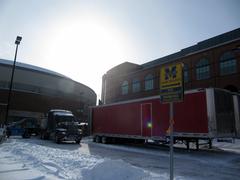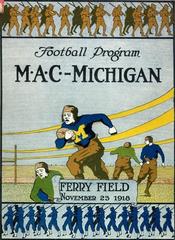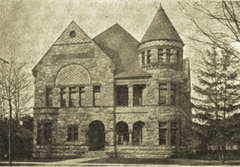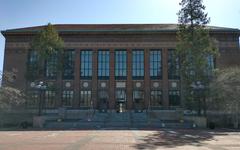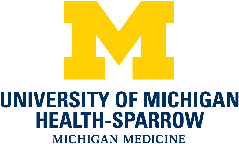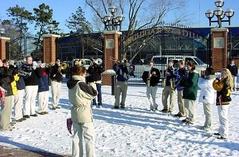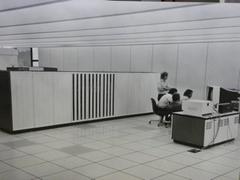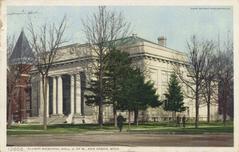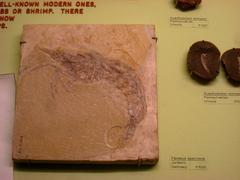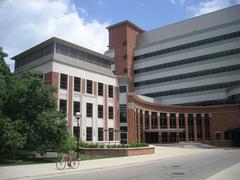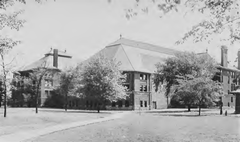Ford Nuclear Reactor Visiting Hours, Tickets, and Ann Arbor Historical Sites Guide
Date: 04/07/2025
Introduction
The Ford Nuclear Reactor (FNR), located on the University of Michigan’s North Campus in Ann Arbor, is an enduring symbol of scientific advancement, education, and memorial dedication. Though decommissioned in 2003, the FNR’s legacy thrives within the Phoenix Memorial Laboratory—now the Nuclear Engineering Laboratory (NEL)—which continues to foster nuclear science research and commemorate those honored by the Michigan Memorial Phoenix Project. This guide provides a comprehensive overview of the FNR’s history, visiting information, and surrounding attractions, ensuring an enriching experience for anyone interested in science, engineering, or Ann Arbor’s heritage (Michigan Memorial Phoenix Project; University of Michigan NERS History; University of Michigan Campus Visitor Guide).
Table of Contents
- Introduction
- Origins and Historical Context
- Construction and Operation
- Scientific Contributions and Research Impact
- Cultural and Societal Significance
- Decommissioning and Legacy
- Visiting Information
- Transformation to the Nuclear Engineering Laboratory
- Frequently Asked Questions (FAQ)
- Summary and Travel Tips
- References
Origins and Historical Context
The Ford Nuclear Reactor was conceived as part of the Michigan Memorial Phoenix Project (MMPP), established in 1948 as a living memorial to 585 University of Michigan community members lost during World War II. The project’s mission was to promote the peaceful use of atomic energy and propel scientific progress in a postwar world. The FNR, funded by a $1 million Ford Motor Company donation, became the first reactor commissioned by a non-governmental institution, symbolizing a new era in university-based nuclear research.
Construction and Operation
Construction of the FNR began in 1955 following Atomic Energy Commission licensing. The facility was dedicated on November 16, 1956, and achieved first criticality on September 19, 1957. The swimming pool-type design featured a 55,000-gallon water pool, enabling hands-on training and research in a safe environment. Initially operating at 1 MW—and later upgraded to 2 MW for enhanced research capacity—the reactor was integral to the development of nuclear science at Michigan and across the nation (Department of Nuclear Engineering and Radiological Sciences History; Ford Nuclear Reactor Timeline).
Scientific Contributions and Research Impact
Nuclear Engineering Education
The FNR became the cornerstone of the university’s nuclear engineering curriculum, which launched formally in 1958. It offered unparalleled opportunities for hands-on experiments in reactor physics, neutron activation analysis, radiation detection, and nuclear instrumentation. Generations of students, researchers, and visiting scholars benefited from direct reactor access, an experience unique among American universities (University of Michigan NERS).
Research and Innovation
The reactor supported a diverse array of research, including:
- Neutron Activation Analysis: Enabled trace element studies in fields ranging from geology to biology.
- Isotope Production: Facilitated the production of medical and industrial isotopes.
- Radiation Effects Studies: Informed material science and reactor safety by examining the impact of irradiation on various materials.
- National and International Collaboration: The FNR participated in the U.S. Department of Energy’s Reactor Sharing Program, expanding research opportunities to other institutions (DOE Reactor Sharing Program).
Cultural and Societal Significance
Symbol of the Atomic Age
The FNR represented the optimism and complexity of the Atomic Age, serving as both a scientific beacon and a public outreach hub. Its signature blue Cherenkov glow became iconic, and the facility was frequently featured in campus tours and open houses, helping demystify nuclear technology for the community.
Community Engagement
The MMPP and FNR were deeply integrated into local life, involving public education, emergency preparedness collaborations, and transparent decommissioning processes. The Phoenix Memorial Laboratory remains a living memorial, preserving the site’s commemorative and educational functions (University of Michigan Campus Visitor Guide).
Decommissioning and Legacy
Operational costs and evolving research priorities led to the FNR’s decommissioning in 2003. By 2006, all nuclear materials had been safely removed, and the building was transformed into the Nuclear Engineering Laboratory (NEL)—a modern research hub that retains historical features such as the original reactor control panel (Lab Manager).
Visiting Information
Hours and Accessibility
- Phoenix Memorial Laboratory/NEL Address: 2301 Bonisteel Blvd, North Campus, Ann Arbor, MI.
- Regular Hours: Monday–Friday, 8:00 AM–5:00 PM. Access may be limited during university holidays or special events.
- General Access: The building’s interior is not open for casual walk-in visits. Public access is allowed during scheduled tours, open houses, and specific university events only.
- Accessibility: The facility is fully accessible, equipped with ramps, elevators, and accessible restrooms.
Tours and Events
- Guided Tours: Offered during designated open houses, alumni weekends, and educational outreach events. Advance registration is required. Tours typically include:
- Historical exhibits (e.g., reactor control panel, commemorative displays)
- Interactive demonstrations (e.g., virtual control room simulator)
- Presentations on ongoing research and the site’s memorial function
- Educational Programs: Programs like Harper Academy 4 Future Nuclear Engineers and summer schools occasionally include public lectures and workshops (Harper Academy).
Visitor Tips
- Always check NERS Department Events and the University of Michigan events calendar for up-to-date schedules.
- Register for events early due to limited capacity.
- Bring photo ID for check-in.
- Observe all posted safety and photography guidelines.
Nearby Ann Arbor Attractions
Enhance your visit with these nearby sites:
- Gerald R. Ford Presidential Library
- University of Michigan Museum of Natural History
- Kelsey Museum of Archaeology
- Detroit Observatory
- Nichols Arboretum
- Duderstadt Center
- Lurie Engineering Center (thetouristchecklist.com)
Transformation to the Nuclear Engineering Laboratory
After decommissioning, the FNR building was redesigned into the NEL, supporting cutting-edge research in nuclear security, radiation detection, and clean energy. Key features include:
- Five major research laboratories specializing in nuclear measurement, nonproliferation, and advanced imaging.
- Preserved historical elements such as the original reactor control panel and commemorative displays.
- Collaborations with national labs and initiatives like the Fastest Path to Zero.
For more on the NEL and its research, visit Lab Manager and NERS Department.
Frequently Asked Questions (FAQ)
Q: Can I visit the Ford Nuclear Reactor building?
A: The reactor is decommissioned and not open for daily visits, but the building (NEL) is accessible during scheduled events and tours.
Q: Are tickets required for tours?
A: Most tours require advance registration. Some events are free, others may have nominal fees.
Q: Is the facility accessible?
A: Yes, NEL is fully accessible for visitors with disabilities.
Q: Is the site safe?
A: The facility has been fully decontaminated, posing no radiation risk.
Q: What about photographs?
A: Photography is allowed in public areas but may be restricted in active research spaces. Always check with your guide.
Q: Where can I find more information?
A: Visit the NERS Department website and University of Michigan Campus Visitor Guide.
Summary and Travel Tips
The Ford Nuclear Reactor and its transformation into the Nuclear Engineering Laboratory represent a unique convergence of memorial dedication, scientific innovation, and educational leadership. While the original reactor is no longer operational, visitors can experience its legacy through public tours, preserved exhibits, and ongoing research at the NEL. To make the most of your visit:
- Check official university resources for upcoming events.
- Register early for tours.
- Pair your visit with other Ann Arbor historical and cultural attractions.
- Download the Audiala app for guided tours and current information.
Embrace the opportunity to connect with both the history and future of nuclear science at this remarkable Ann Arbor landmark (NERS Department; Lab Manager Article; University of Michigan News).
References
- Michigan Memorial Phoenix Project (MMPP)
- Department of Nuclear Engineering and Radiological Sciences History
- University of Michigan Campus Visitor Guide
- University of Michigan Nuclear Engineering and Radiological Sciences
- Lab Manager Article
- University of Michigan News
- University of Michigan Engineering News
- DOE Reactor Sharing Program
- Bentley Historical Library
- The Tourist Checklist – Ann Arbor
- Ford Nuclear Reactor Timeline
- Harper Academy
